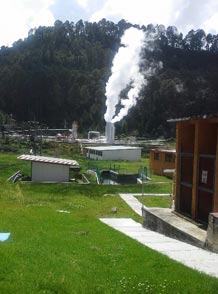Lehigh University
P.C. Rossin College of Engineering and Applied Science
Geothermal Energy
The Energy Research Center is leading an effort to investigate the feasibility of, and test methods of using supercritical carbon dioxide (sCO2), produced by fossil fuel power plants, to enhance the extraction of geothermal energy for power generation applications. CO2 as a geothermal heat mining fluid also provides the added benefit of carbon storage within the geothermal formation. CO2 is expected to be available in the future from carbon capture systems added to fossil-fired power plants for greenhouse gases abatement. This research is part of a project performed in collaboration with the Faculty of Mechanical Engineering at the Universidad Michoacana de San Nicolas de Hidalgo (UMSNH) in Mexico under funding from Mexico’s Ministry of Energy (SENER) and the National Council for Science and Technology (CONACYT).
Traditional hydrothermal systems require significant amounts of water, a high permeability and porous formation, and sufficiently high subsurface temperatures to be suitable for geothermal power generation. In this approach, water or brine will be replaced with sCO2 that has been heated and pressurized by the plant CO2 capture system. Because of its lower viscosity and larger density differences at different temperatures, sCO2 is more mobile than water and should therefore permeate more readily into the geothermal reservoir, expanding the range of usable natural geothermal formations. Different options are being investigated for the use of the heated sCO2, such as direct power generation with turbines designed for sCO2, interaction with a heat exchanger working with an organic fluid thermal cycle, district heating, and utilization in the process to capture CO2 at a fossil fuel-fired power plant.

Current estimations of heat mining potential using sCO2 were performed using the TOUGH2 computer software. Simulations for three reservoirs rated at 260 165 and 95°C indicate that CO2-based systems have better heat mining potential than H2O-based systems, corresponding to enhanced heat extraction rates as high as 160 percent with respect to the H2O-based systems, with the heat mining benefit by sCO2 increasing in inverse proportion to the site subsurface temperature. Additional simulations for twenty-one characterized geothermal sites in Mexico estimate a total power generation potential with sCO2 of 1,161 MWe, while able to sequester approximately 72 million tons of CO2, over an expected 30-year life of the reservoirs. This project will include testing at a 300 kWe experimental geothermal unit utilizing sCO2 and an organic heat-exchange fluid.
Related Links:
